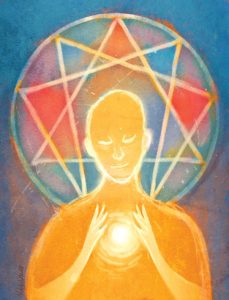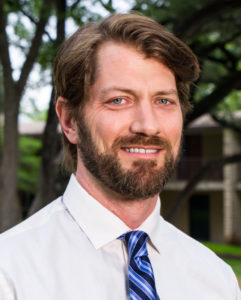
This past summer, I began exploring the Enneagram, a grid of personality/spirituality types you generally see depicted in that vaguely satanic-looking nine-point star within a circle. I’ve heard about it from students and colleagues over the years, and I decided it was time to see for myself. I read Chistopher Heurtz’s helpful book The Sacred Enneagram and parts of the one his teacher, Richard Rohr, wrote with another student, Andreas Ebert: The Enneagram: A Christian Perspective.
My goal in the reading was not only to figure out my own type among the nine numbers. On that score, I’m still not quite clear whether I’m a Four or a Nine, though I suspect some of you reading have a guess about that. On the one hand, I like to make peace, I prefer to float above chaos, and I fumble over myself when I get angry. So Nine. On the other hand, I secretly think I’m too special for the Enneagram. So Four.
My more immediate goal was to expand my vocabulary for conversations about faith, prayer, and just generally the navigating of life.
There are many things I’m still working to understand about the Enneagram. My 70,000-feet-high assessment, at this early stage of exploration, is that this tool, like some others, is at its heart a way of saying that humans are unique, and also that they demonstrate patterns. Recognizing those patterns can help us become more aware of who we are and more aware of how to relate to those around us. What is especially helpful about this particular tool, at least for me, is the way it names these patterns not just statically but dynamically: not just “these are the sorts of people there are” but “the sort that engages the world in this way tends in this direction at these times and that direction at others.”
One of the exciting discoveries I made in this reading was that there is some significant resonance with the work I’ve done on Christian perfection, or the process and end of a life lived in Christ. I especially saw this in Rohr’s observation that all of the types have connections to the character of God. To take the aforementioned two candidates for my type: those who strive for peaceful and harmonious relationships first and foremost are anchored in the peacefulness of God, while those driven by the desire to express their singularity are particular expressions of the uniqueness of God. In that sense, we can see the Enneagram as a careful drawing out of one of the deepest and most central ideas of Christian theology: we are all made in God’s image. As Augustine noted, God is peaceful and unique at once – and also loving and powerful and joyous and wise and creative. Those beings who are limited images of this God are not all those characteristics at the same time, but rather toward one or other of the attributes.
This is something like what I called a “diagonal advance”: we don’t know who we are without knowing who God is, and yet we don’t know who God is until we “try God out” in our own earthly becoming, in our own peculiar and various ways.
Because we remain limited even in this becoming, we need some thoughtful guidance about how to do that well, how to recognize when we’re doing it poorly, and especially how to engage others who are guided by another of the divine attributes. The types are identical for God, I imagine Augustine as saying, but they are necessarily diverse on earth. And this observation ushers in the possibilities that tend to accompany difference among us: challenge, hope, discovery, beauty, fear, failure, violence …
One critique of the theology surrounding this tool has to do with the “patterns of motion” I mentioned above. For Rohr, this motion is primarily one of reclaiming “our original soul space” (45), a space that we’ve abandoned after childhood as the pressures and threats of the world around us have imposed themselves. “We’re all looking for ways to get back to our True Self” is the way that Heurtz (p. 27) puts it. There are two problems with this image.
First of all, it sets up a bifurcation between Me and World, suggesting that the former has been misdirected by the latter. For various reasons that I will not take time here to explain, I am more compelled by an integrated explanation of these two terms, so that “I” am part of a world that is constantly creating and recreating boundaries, including the boundary between myself and the world around me.
Secondly, it locks us into finding our identities in the hidden past, rather than seeing that past, along with the tensions of the present, as a window into God’s future. 1 John teaches us that “we are God’s children now; what we will be has not yet been revealed” (3:2). It cannot have been revealed, the rest of the verse says, because we are awaiting the coming of Christ, and Christ is the one who reveals how all things are what they are only as finite expressions of the infinite God.
In technical theological language, our identity is eschatological before it is protological. In my writing on perfection, I discovered that the church fathers, and especially Maximus the Confessor, worked out this important explanation of what it means to be the creatures God made by integrating Aristotle, and especially Aristotle’s notion of a telos or a creature’s ultimate good, into their understanding of spirituality. Our “true self,” to use language that Maximus did not, is the one resting for all eternity in the Person of Christ as that Person moves in and among the Father and the Spirit.
If I could be so bold as to amend Rohr and his students, then, I would say that the type that I am is the peculiar expression of God’s being that God imagined while fashioning me and knowing me in my mother’s womb. I, however, experience God’s imagination as an invitation from the returning Christ, who will, for the first time, fully reveal to me what I am. Including the “number” or pattern by which God made me.
That’s not to say that I can’t make a pretty good guess now. The types are more useful prior to the eschaton, I imagine, than after. But it seems important to let the coming Christ, rather than my imagined childhood true self, have the final say.
One place where I find all of this to be most immediately helpful for Christians is in guiding certain of our prayers. If I am an expression of God’s truth (I’m looking at you, Eights), then I might find myself tempted to manage the truthfulness of the world, perhaps to control the variables that other wills and ideas bring to the table. Naming myself as this sort of person allows me to speak a word of praise that honors God for God’s truthfulness, and shrinks me down to the finite expression of that attribute that God made me to be. “God, you are the world’s Truth.” I am not God, but only a limited image of God’s truthfulness, sharing a space in the world with other, differently limited images of God.
In the end, we’re all differently limited. That, perhaps, is the grace and mercy and edification that the Enneagram offers us. To learn to see ourselves and those around us as icons of various divine attributes – that would be a significant step on the journey toward what Maximus framed as “the rest of the loving heart in the eternal motion around the beloved.”
What attribute of God do you think is reflected in your personality?
How might this recognition change the way you pray?
 Dr. Anthony Baker joined the seminary faculty in 2004. He teaches classes in both historical theology (focusing on a figure, an era, or a school of thought) and constructive theology (the building of persuasive arguments about God and creation). He is the author of Diagonal Advance: Perfection in Christian Theology as well as various articles in Modern Theology, Political Theology, The Journal of Anglican Studies, Anglican Theological Review, Heythrop Journal and other journals and collections. He is currently working on a book that explores theological themes in the works of Shakespeare. Professor Baker is editor-in-chief of the Anglican Theological Review, and he is the theologian-in-residence at Saint Julian’s Episcopal Church in north Austin, where he and his three children attend.
Dr. Anthony Baker joined the seminary faculty in 2004. He teaches classes in both historical theology (focusing on a figure, an era, or a school of thought) and constructive theology (the building of persuasive arguments about God and creation). He is the author of Diagonal Advance: Perfection in Christian Theology as well as various articles in Modern Theology, Political Theology, The Journal of Anglican Studies, Anglican Theological Review, Heythrop Journal and other journals and collections. He is currently working on a book that explores theological themes in the works of Shakespeare. Professor Baker is editor-in-chief of the Anglican Theological Review, and he is the theologian-in-residence at Saint Julian’s Episcopal Church in north Austin, where he and his three children attend.

